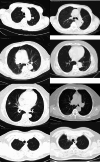The clinical effect of thoracoscopic segmentectomy in the treatment of lung malignancies less than 2CM in diameter
- PMID: 39472879
- PMCID: PMC11520890
- DOI: 10.1186/s13019-024-03030-0
The clinical effect of thoracoscopic segmentectomy in the treatment of lung malignancies less than 2CM in diameter
Abstract
Objective: To investigate the clinical effect of thoracoscopic segmentectomy in the treatment of lung malignancies less than 2CM in diameter.
Methods: In this retrospective study, a total of 103 patients with lung cancer who received outpatient or inpatient treatment from December 2020 to May 2022 were selected and divided into the lobectomy group (n = 48) and the segmentectomy group (n = 55) according to different surgical methods. The lobectomy group was treated with thoracoscopic lobectomy, while the segmentectomy group was treated with thoracoscopic segmentectomy. The prognostic effect, complications, blood gas level and respiratory function indexes of the two groups were observed and compared.
Results: The general data of the two groups of patients, such as gender, age, course of disease, body mass index, lesion diameter, lesion site and pathological type, were analyzed by statistical software. There was no statistical significance in the operation time and the number of lymph node dissection between the two groups (P > 0.05), while the drainage volume and intraoperative blood loss in the segmentectomy group were lower than those in the lobectomy group, and the drainage time and hospital stay were shorter than those in the lobectomy group, with statistical significance (P < 0.05). Before treatment, there were no statistically significant differences in various lung function indexes between the two groups (P > 0.05). After treatment, the values of FVC, FEV1 and FEV1/FVC in each group had different amplitude changes, and the values of FVC, FEV1 and FEV1/FVC in the segmentectomy group were significantly higher than those in the lobectomy group, with statistical significance (P < 0.05). Thoracoscopic segmentectomy showed a lower incidence of respiratory complications (P = 0.042) and higher pulmonary air leak (P = 0.023) than thoracoscopic lobectomy. After propensity score-matched analysis, respiratory complications remained significantly higher in thoracoscopic segmentectomy (P = 0.017). However, the difference in the total complication rate between the two groups was not statistically significant (P > 0.05). There were no differences during the 2-year follow-up (median follow-up in months: 18.4; interquartile range, 14.8-21.3) in terms of overall survival (P = 0.49) and disease-free survival (P = 0.34) between groups (P > 0.05).
Conclusions: For patients with lung cancer less than 2 cm in diameter, thoracoscopic segmentectomy can achieve good short-term efficacy, with rapid postoperative recovery and little impact on lung function, which may be helpful to improve patients' postoperative quality of life.
Keywords: Lung cancer; Pulmonary nodules; Segmentectomy of lung; Thoracoscopic.
© 2024. The Author(s).
Conflict of interest statement
Ensure that all authors have disclosed any and all conflicts of interest.
Figures
References
-
- Bayfield NGR, Bibo L, Wang E, Edelman J. Left upper lobe multi-segmentectomy versus lobectomy for early-stage lung cancer: a meta-analysis. Heart Lung Circ. 2023;32(5):596–603. - PubMed
MeSH terms
LinkOut - more resources
Full Text Sources
Medical




